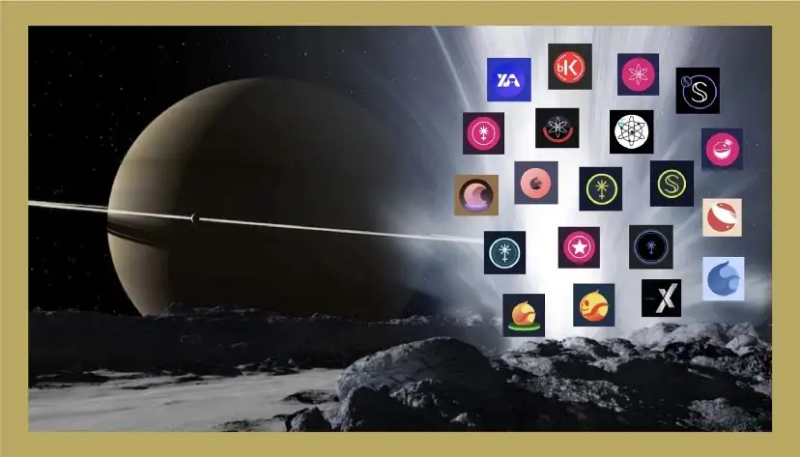Compilation of the original text: Deep Tide TechFlow
Compilation of the original text: Deep Tide TechFlow

wave of liquidity
During 2022, I covered liquidity staking protocols in Cosmos, starting with Prism Derivatives in January, and continuing with StakeEasy's novel, multi-faceted token model last month. The pace of innovation is not slowing down, and 2023 has seen many exciting announcements and protocol launches including: pSTAKE, Shade, Stride, BackBone Labs, and Quicksilver.
The purpose of this article is to provide an up-to-date overview of most Liquid Staking Derivatives (LSDs) currently available on Cosmos. More importantly, I want to check the dashboard to see how much usage these dApps, protocols and blockchains have.
LSDs in the universe
Take a look at the image below for the protocols that provide liquidity staking in Cosmos, and the names of all circulating tokens. As you can see, the field has become more crowded.


Amount of LSDs
As the LSD token gains popularity and more Cosmos participants take advantage of its economic benefits, the volume and associated value of the LSD token is steadily increasing. The chart and table below summarize the current state of the LSD market in Cosmos.


New Features and Opportunities
governance
governance
Typically, when you deploy your token in DeFi, you give up the ability to participate in governance voting. However,Blockchains like Stride and Quicksilver will use interchain accounts to solve this problem and enable users who stake their assets to liquidity staking providers to also participate in governance.
A perfect example of this functionality is the Stride team, which recently announced their update roadmap, as well as the phased rollout of their liquidity governance plan (see image below).

Quicksilver will launch its initial qAssets suite this month with Stargaze's STARS, followed by Juno Network's JUNO, and Osmosis' OSMO.
After these first three, ATOMs from the Cosmos Hub will follow. The team announced that it will create a liquidity pool for qAssets on Osmosis.
Liquidity Staking Module
One of the most popular features is the Liquidity Staking Module (LSM). This will allow users to transfer their delegation to a liquidity staking provider without first unbonding it.
I expect that allowing liquidity staking providers to mint LSD against already-locked governance tokens will significantly increase usage of provider products, and participation in Cosmos DeFi.
Note that liquidity staking providers do not currently offer this functionality. A number of protocols have announced that they will begin incorporating this functionality as soon as the Liquidity Staking Module (LSM) is released from the Cosmos Hub.
Liquidity Pool Incentives
All protocols are actively forming partnerships with exchanges around Cosmos to create new DeFi opportunities. For example, Stride and Shade made a joint announcement about a new liquidity pool for derivative tokens at the launch of ShadeSwap, including:
stATOM — ATOM
stOSMO — OSMO
stJUNO — JUNO
stATOM — stOSMO
SHD — stATOM
stkdSCRT — sSCRT。
And, some of these mining pools will get double incentives.
The protocol also provides external incentives to reward participants for deploying their LSD in DeFi, including Osmosis, Astroport, Crescent, KavaSwap, SiennaSwap, rDEX, and Loop AMM. Liquidity staking providers offering rewards include:
StakeEasy — SEASY
Stride — STRD
Crescent — CRE
Kava — KAVA
StaFi Hub — FIS
Astroport — ASTRO。
borrow money
borrow money
airdrop
airdrop
Finally, these protocols are also airdropping their tokens. Stride has started their airdrop program, and other companies have announced upcoming airdrops of their governance tokens, including StakeEasy and Quicksilver.
For example, the Quicksilver team announced a continuous airdrop where QCK tokens will be airdropped to creators on the new blockchain. The team also announced a participation rewards program where users can earn additional QCK tokens based on their validator choices. The goal here is to promote decentralization and incentivize delegation to validators with lower levels of voting power but higher levels of performance.
Rapid growth
The growth of liquidity staking in Cosmos has reached insane speed. Surprisingly, one of the first blockchains in the universe to offer LSD (Terra in 2021) still has an impressive set of options to choose from. Another protocol that claims to be the first to offer LSD in Cosmos is pSTAKE. The team's original product even predates IBC and was developed as an EVM-based solution. They just launched their latest product - a brand new stkATOM, which now has full support for IBC and interchain accounts.
The LSD of the Kava blockchain — bKAVA is a relatively newcomer to the project, but one of the fastest rising, having launched less than three months ago. This blockchain provides participants with higher earning rewards in its earning and boosting programs.
looming economic expansion
As more DeFi dApps launch their products in the coming months, the opportunities to deploy LSD will only expand. Not only is the number of tokens staked increasing, but the overall USD equivalent of staked assets is also on the rise due to the launch of the new LSD product. This is especially impressive considering the depressed token prices in this bear market.
Rising usage will also lead to an increase in the daily transaction volume of Cosmos DeFi. This is a welcome development as standard staking and LP APRs have been steadily declining across the ecosystem.
Original link